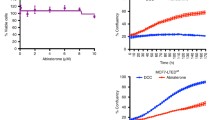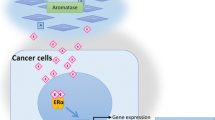Abstract
Third generation aromatase inhibitors (AI) have shown good clinical efficacy in comparison to the anti-estrogen tamoxifen. The steroidal AI, exemestane (EXE) has previously been shown to act as an androgen, but this report demonstrates the estrogen-like activity of EXE. Based on genome-wide microarray analysis, high correlation was seen between EXE-Only (EXE O, hormone-free) and hormone-containing AI-resistant lines. In addition, the top regulated genes in the EXE O lines were mostly estrogen-responsive genes. This estrogen-like activity of EXE was further validated using estrogen receptor (ER) activity assays, where in comparison to 17β-estradiol (E2), EXE was able to induce ER activity, though at a higher concentration. Also, this EXE-mediated ER activity was blocked by the ER antagonist ICI as well as the ERα-specific antagonist methyl-piperidino-pyrazole (MPP). Similarly, EXE was able to induce proliferation of breast cancer cell lines, MCF-7 and MCF-7aro, as well as activate transcription of known estrogen-responsive genes, i.e., PGR, pS2 and AREG. These results suggest that EXE does have weak estrogen-like activity.




Similar content being viewed by others
References
Santner SJ, Chen S, Zhou D, Korsunsky Z, Martel J, Santen RJ (1993) Effect of androstenedione on growth of untransfected and aromatase-transfected MCF-7 cells in culture. J Steroid Biochem Mol Biol 44(4–6):611–616. doi:10.1016/0960-0760(93)90267-Z
Yue W, Wang JP, Hamilton CJ, Demers LM, Santen RJ (1998) In situ aromatization enhances breast tumor estradiol levels and cellular proliferation. Cancer Res 58(5):927–932
Miller WR, O’Neill J (1987) The importance of local synthesis of estrogen within the breast. Steroids 50(4–6):537–548. doi:10.1016/0039-128X(87)90037-7
Bulun SE, Price TM, Aitken J, Mahendroo MS, Simpson ER (1993) A link between breast cancer and local estrogen biosynthesis suggested by quantification of breast adipose tissue aromatase cytochrome P450 transcripts using competitive polymerase chain reaction after reverse transcription. J Clin Endocrinol Metab 77(6):1622–1628. doi:10.1210/jc.77.6.1622
Esteban JM, Warsi Z, Haniu M, Hall P, Shively JE, Chen S (1992) Detection of intratumoral aromatase in breast carcinomas. An immunohistochemical study with clinicopathologic correlation. Am J Pathol 140(2):337–343
James VH, McNeill JM, Lai LC, Newton CJ, Ghilchik MW, Reed MJ (1987) Aromatase activity in normal breast and breast tumor tissues: in vivo and in vitro studies. Steroids 50(1–3):269–279. doi:10.1016/0039-128X(83)90077-6
Lu Q, Nakmura J, Savinov A, Yue W, Weisz J, Dabbs DJ et al (1996) Expression of aromatase protein and messenger ribonucleic acid in tumor epithelial cells and evidence of functional significance of locally produced estrogen in human breast cancers. Endocrinology 137(7):3061–3068. doi:10.1210/en.137.7.3061
Santen RJ, Martel J, Hoagland M, Naftolin F, Roa L, Harada N et al (1994) Stromal spindle cells contain aromatase in human breast tumors. J Clin Endocrinol Metab 79(2):627–632. doi:10.1210/jc.79.2.627
Coombes RC, Hall E, Gibson LJ, Paridaens R, Jassem J, Delozier T et al (2004) A randomized trial of exemestane after two to three years of tamoxifen therapy in postmenopausal women with primary breast cancer. N Engl J Med 350(11):1081–1092. doi:10.1056/NEJMoa040331
Goss PE, Ingle JN, Martino S, Robert NJ, Muss HB, Piccart MJ et al (2005) Randomized trial of letrozole following tamoxifen as extended adjuvant therapy in receptor-positive breast cancer: updated findings from NCIC CTG MA.17. J Natl Cancer Inst 97(17):1262–1271
Howell A, Cuzick J, Baum M, Buzdar A, Dowsett M, Forbes JF et al (2005) Results of the ATAC (Arimidex, Tamoxifen, alone or in combination) trial after completion of 5 years’ adjuvant treatment for breast cancer. Lancet 365(9453):60–62. doi:10.1016/S0140-6736(04)17666-6
Brueggemeier RW (2001) Aromatase, aromatase inhibitors, and breast cancer. Am J Ther 8(5):333–344. doi:10.1097/00045391-200109000-00007
Wang X, Chen S (2006) Aromatase destabilizer: novel action of exemestane, a food and drug administration-approved aromatase inhibitor. Cancer Res 66(21):10281–10286. doi:10.1158/0008-5472.CAN-06-2134
Ariazi EA, Leitao A, Oprea TI, Chen B, Louis T, Bertucci AM et al (2007) Exemestane’s 17-hydroxylated metabolite exerts biological effects as an androgen. Mol Cancer Ther 6(11):2817–2827. doi:10.1158/1535-7163.MCT-07-0312
di Salle E, Ornati G, Giudici D, Lassus M, Evans TR, Coombes RC (1992) Exemestane (FCE 24304), a new steroidal aromatase inhibitor. J Steroid Biochem Mol Biol 43(1–3):137–143. doi:10.1016/0960-0760(92)90198-R
Lonning PE, Bajetta E, Murray R, Tubiana-Hulin M, Eisenberg PD, Mickiewicz E et al (2000) Activity of exemestane in metastatic breast cancer after failure of nonsteroidal aromatase inhibitors: a phase II trial. J Clin Oncol 18(11):2234–2244
Goss PE, Hadji P, Subar M, Abreu P, Thomsen T, Banke-Bochita J (2007) Effects of steroidal and nonsteroidal aromatase inhibitors on markers of bone turnover in healthy postmenopausal women. Breast Cancer Res 9(4):R52. doi:10.1186/bcr1757
Sun XZ, Zhou D, Chen S (1997) Autocrine and paracrine actions of breast tumor aromatase. A three-dimensional cell culture study involving aromatase transfected MCF-7 and T-47D cells. J Steroid Biochem Mol Biol 63(1–3):29–36. doi:10.1016/S0960-0760(97)00068-X
Bradford MM (1976) A rapid and sensitive method for the quantitation of microgram quantities of protein utilizing the principle of protein-dye binding. Anal Biochem 72:248–254. doi:10.1016/0003-2697(76)90527-3
Chen S, Masri S, Hong Y, Wang X, Phung S, Yuan YC, Wu X (2007) New experimental models for aromatase inhibitor resistance. J Steroid Biochem Mol Biol 106(1–5):8–15
Chen S, Masri S, Wang X, Phung S, Yuan YC, Wu X (2006) What do we know about the mechanisms of aromatase inhibitor resistance? J Steroid Biochem Mol Biol 102(1–5):232–240
Masri S, Phung S, Wang X, Wu X, Yuan YC, Wagman L et al (2008) Genome-wide analysis of aromatase inhibitor-resistant, tamoxifen-resistant, and long-term estrogen-deprived cells reveals a role for estrogen receptor. Cancer Res 68(12):4910–4918. doi:10.1158/0008-5472.CAN-08-0303
Itoh T, Karlsberg K, Kijima I, Yuan YC, Smith D, Ye J et al (2005) Letrozole-, anastrozole-, and tamoxifen-responsive genes in MCF-7aro cells: a microarray approach. Mol Cancer Res 3(4):203–218
Kijima I, Itoh T, Chen S (2005) Growth inhibition of estrogen receptor-positive and aromatase-positive human breast cancer cells in monolayer and spheroid cultures by letrozole, anastrozole, and tamoxifen. J Steroid Biochem Mol Biol 97(4):360–368. doi:10.1016/j.jsbmb.2005.09.003
Wang X, Masri S, Phung S, Chen S (2008) The role of amphiregulin in exemestane-resistant breast cancer cells: evidence of an autocrine loop. Cancer Res 68(7):2259–2265
Harrington WR, Sheng S, Barnett DH, Petz LN, Katzenellenbogen JA, Katzenellenbogen BS (2003) Activities of estrogen receptor alpha- and beta-selective ligands at diverse estrogen responsive gene sites mediating transactivation or transrepression. Mol Cell Endocrinol 206(1–2):13–22. doi:10.1016/S0303-7207(03)00255-7
Compton DR, Sheng S, Carlson KE, Rebacz NA, Lee IY, Katzenellenbogen BS et al (2004) Pyrazolo[1, 5-a]pyrimidines: estrogen receptor ligands possessing estrogen receptor beta antagonist activity. J Med Chem 47(24):5872–5893. doi:10.1021/jm049631k
Chien AJ, Goss PE (2006) Aromatase inhibitors and bone health in women with breast cancer. J Clin Oncol 24(33):5305–5312. doi:10.1200/JCO.2006.07.5382
Lonning PE (2006) Bone safety of aromatase inhibitors versus tamoxifen. Int J Gynecol Cancer 16(Suppl 2):518–520. doi:10.1111/j.1525-1438.2006.00685.x
Perez EA (2007) Safety profiles of tamoxifen and the aromatase inhibitors in adjuvant therapy of hormone-responsive early breast cancer. Ann Oncol 18(Suppl 8):viii26–viii35
Coleman RE, Banks LM, Girgis SI, Kilburn LS, Vrdoljak E, Fox J et al (2007) Skeletal effects of exemestane on bone-mineral density, bone biomarkers, and fracture incidence in postmenopausal women with early breast cancer participating in the Intergroup Exemestane Study (IES): a randomised controlled study. Lancet Oncol 8(2):119–127. doi:10.1016/S1470-2045(07)70003-7
Goss PE, Qi S, Josse RG, Pritzker KP, Mendes M, Hu H et al (2004) The steroidal aromatase inhibitor exemestane prevents bone loss in ovariectomized rats. Bone 34(3):384–392. doi:10.1016/j.bone.2003.11.006
Goss PE, Qi S, Cheung AM, Hu H, Mendes M, Pritzker KP (2004) Effects of the steroidal aromatase inhibitor exemestane and the nonsteroidal aromatase inhibitor letrozole on bone and lipid metabolism in ovariectomized rats. Clin Cancer Res 10(17):5717–5723. doi:10.1158/1078-0432.CCR-04-0438
Eriksen EF, Hodgson SF, Eastell R, Cedel SL, O’Fallon WM, Riggs BL (1990) Cancellous bone remodeling in type I (postmenopausal) osteoporosis: quantitative assessment of rates of formation, resorption, and bone loss at tissue and cellular levels. J Bone Miner Res 5(4):311–319
Jilka RL, Takahashi K, Munshi M, Williams DC, Roberson PK, Manolagas SC (1998) Loss of estrogen upregulates osteoblastogenesis in the murine bone marrow. Evidence for autonomy from factors released during bone resorption. J Clin Invest 101(9):1942–1950. doi:10.1172/JCI1039
Parfitt AM, Mathews CH, Villanueva AR, Kleerekoper M, Frame B, Rao DS (1983) Relationships between surface, volume, and thickness of iliac trabecular bone in aging and in osteoporosis. Implications for the microanatomic and cellular mechanisms of bone loss. J Clin Invest 72(4):1396–1409. doi:10.1172/JCI111096
Di Gregorio GB, Yamamoto M, Ali AA, Abe E, Roberson P, Manolagas SC et al (2001) Attenuation of the self-renewal of transit-amplifying osteoblast progenitors in the murine bone marrow by 17 beta-estradiol. J Clin Invest 107(7):803–812. doi:10.1172/JCI11653
Dang ZC, van Bezooijen RL, Karperien M, Papapoulos SE, Lowik CW (2002) Exposure of KS483 cells to estrogen enhances osteogenesis and inhibits adipogenesis. J Bone Miner Res 17(3):394–405. doi:10.1359/jbmr.2002.17.3.394
Miki Y, Suzuki T, Hatori M, Igarashi K, Aisaki KI, Kanno J et al (2007) Effects of aromatase inhibitors on human osteoblast and osteoblast-like cells: a possible androgenic bone protective effects induced by exemestane. Bone 40(4):876–887. doi:10.1016/j.bone.2006.11.029
Acknowledgement
S. Masri was supported by NIH pre-doctoral training fellowship CA123691 and S. Chen by NIH grants CA044735 and ES08258.
Author information
Authors and Affiliations
Corresponding author
Additional information
Microarray data in this publication has been deposited in NCBIs Gene Expression Omnibus (GEO, http://www.ncbi.nlm.nih.gov/geo/) and is accessible through GEO Series accession number GSE10911.
Rights and permissions
About this article
Cite this article
Masri, S., Lui, K., Phung, S. et al. Characterization of the weak estrogen receptor α agonistic activity of exemestane. Breast Cancer Res Treat 116, 461–470 (2009). https://doi.org/10.1007/s10549-008-0151-x
Received:
Accepted:
Published:
Issue Date:
DOI: https://doi.org/10.1007/s10549-008-0151-x




